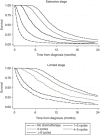Treatment decisions and survival for people with small-cell lung cancer
- PMID: 24398511
- PMCID: PMC3929890
- DOI: 10.1038/bjc.2013.812
Treatment decisions and survival for people with small-cell lung cancer
Abstract
Background: Chemotherapy improves survival for many patients with SCLC, and hence it is important to understand variations in practice and outcomes for this treatment strategy.
Methods: We used the National Lung Cancer Audit and Hospital Episodes Statistics to determine the proportion of patients who received chemotherapy for SCLC, and assess the effects of patient and organisational factors on the odds of receiving chemotherapy and of completing four cycles. We calculated median survival and used Cox regression to determine factors that predicted survival.
Results: Of 15 091 cases of SCLC, 70% received at least one cycle of chemotherapy. More deprived people were less likely to receive chemotherapy, but patients were more likely to receive chemotherapy, and to complete ≥ four cycles, if they were referred to the lung cancer team by their GP. Median survival for those treated with chemotherapy was 12.9 months for limited and 7.3 months for extensive stage disease.
Conclusions: The Linked NLCA and HES data provide real-life measures of survival in people treated with chemotherapy and show how this is influenced by patient and tumour characteristics. These data show the characteristics of patients who are less likely to complete a full course of treatment, an adverse predictor of survival.
Figures


References
-
- Charlson ME, Pompei P, Ales KL, Mackenzie CR. A new method of classifying prognostic co-morbidity in longitudinal-studies—development and validation. J Chronic Dis. 1987;40:373–383. - PubMed
-
- Fukuoka M, Furuse K, Saijo N, Nishiwaki Y, Ikegami H, Tamura T, Shimoyama M, Suemasu K. Randomized trial of cyclophosphamide, doxorubicin, and vincristine versus cisplatin and etoposide versus alternation of these regimens in small-cell lung cancer. J Natl Cancer Inst. 1991;83:855–861. - PubMed
-
- Health and social care information centre 2013. National Lung Cancer Audit [Online]. Available at: http://www.hscic.gov.uk/lung (accessed 7th August 2013).
Publication types
MeSH terms
Substances
LinkOut - more resources
Full Text Sources
Other Literature Sources
Medical
Molecular Biology Databases

